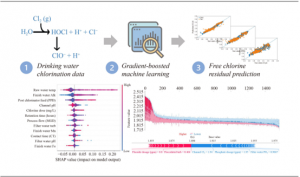CHINA, December 15, 2023 /EINPresswire.com/ -- Chlorine-based disinfection is a critical practice in conventional drinking water treatment (DWT). It is essential for inactivating pathogenic microbes in raw water supplies, thereby eliminating health risks in finished water and throughout distribution systems. An important indicator of disinfection efficiency is the Free Chlorine Residual (FCR), a regulated disinfection parameter in the U.S. that indirectly measures disinfectant power for preventing microbial recontamination during DWT and distribution. However, maintaining optimal FCR levels can be challenging due to varying water quality and operational conditions.
In a new study published on 28 September 2023, in the journal Frontiers of Environmental Science & Engineering, researchers from Georgia Institute of Technology have developed an innovative machine learning (ML) model to improve the forecasting of FCR levels. The model, which uses a gradient-boosting ML method known as CatBoost, was trained on a year's worth of data from a real full-scale chlorine disinfection system in Georgia, USA. This data encompassed a variety of water quality parameters and operational process data.
In this groundbreaking study, the research team employed a four-phase modeling approach, starting with a base case model and methodically advancing through iterations involving rolling average models, parameter consolidation, and intuitive parameter models. The models underwent meticulous refinement using cross-validation and Bayesian optimization to enhance their predictive performance, with the final model's efficacy evidenced by an impressive coefficient of determination (R2) of 0.937. Integral to this success was the application of the SHapley Additive explanation (SHAP) method, which illuminated the significant, albeit non-intuitive, impact of standard drinking water treatment (DWT) operating parameters on Free Chlorine Residual (FCR) prediction accuracy. This comprehensive study not only highlights the potential of machine learning in optimizing chlorine dosages for DWT plant operations but also demonstrates its ability to maintain optimal FCR levels amidst varying input conditions, thereby reinforcing the model’s applicability and reliability in real-world scenarios.
Highlights
● A machine learning approach was applied to predict free chlorine residuals.
● Annual data were obtained from chlorinationunit at a 98 MGD water treatment plant.
● The last model iteration returned a high prediction value (R2 = 0.937).
● Non-intuitive parameters were found to be highly significant to predictions.
This research lays the foundation for data-driven supervision in DWT disinfection. It suggests new process monitoring methods that could provide better information to plant operators for implementing safe chlorine dosing. Moreover, the approach could be adapted to other aspects of water treatment and management, potentially leading to more efficient and safer drinking water supply systems worldwide.
DOI
10.1007/s11783-024-1777-6
Original Source URL
https://doi.org/10.1007/s11783-024-1777-6
Funding information
US Department of Agriculture’s National Institute of Food and Agriculture, Agriculture and Food Research Initiative, Water for Food Production Systems (2018-68011-28371); National Science Foundation (USA) (1936928, 2112533); US Department of Agriculture’ National Institute of Food and Agriculture (2020-67021-31526); US Environmental Protection Agency (840080010).
Lucy Wang
BioDesign Research
email us here




